The smart TV market is experiencing robust growth driven by the rapid evolution of digital entertainment ecosystems, advancements in display technologies, and increasing internet penetration across households. Current market conditions reflect rising consumer preference for integrated streaming platforms and voice-assisted interfaces, enhancing convenience and personalization. Manufacturers are focusing on delivering high-performance models with improved energy efficiency and enhanced connectivity features.
The adoption of over-the-top (OTT) services and smart home integration is further accelerating market demand. The future outlook indicates strong expansion supported by declining display panel costs, the proliferation of 4K and 8K resolutions, and strategic partnerships between TV manufacturers and content providers.
Growth rationale is centered on continuous technological innovation, improved user interfaces, and regional demand diversification Enhanced product accessibility through online channels and competitive pricing strategies are expected to sustain long-term growth, positioning smart TVs as a core component of modern digital households worldwide.
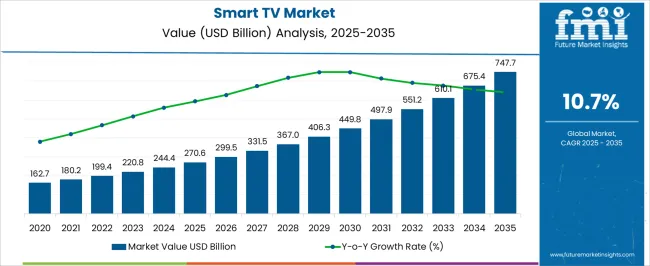
| Metric | Value |
|---|---|
| Smart TV Market Estimated Value in (2025 E) | USD 270.6 billion |
| Smart TV Market Forecast Value in (2035 F) | USD 747.7 billion |
| Forecast CAGR (2025 to 2035) | 10.7% |
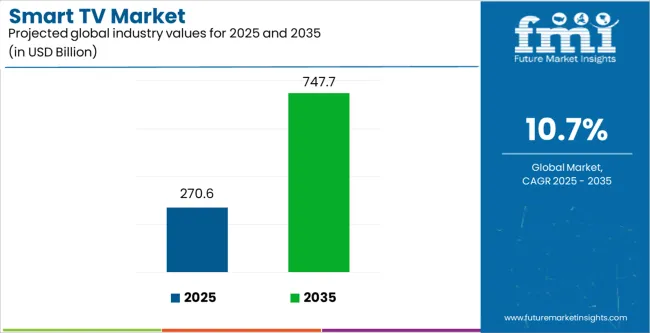
The market is segmented by Operating System, Resolution, Screen Size, Screen Shape, Distribution Channel, and Technology and region. By Operating System, the market is divided into Android TV, Tizen, WebOS, Roku, and Others. In terms of Resolution, the market is classified into 4K UHD TV, HD TV, Full HD TV, and 8K TV. Based on Screen Size, the market is segmented into 46 to 55 Inches, Below 32 Inches, 32 to 45 Inches, 56 to 65 Inches, and Above 65 Inches. By Screen Shape, the market is divided into Flat and Curved. By Distribution Channel, the market is segmented into Offline and Online. By Technology, the market is segmented into LED, OLED, QLED, and Others. Regionally, the market is classified into North America, Latin America, Western Europe, Eastern Europe, Balkan & Baltic Countries, Russia & Belarus, Central Asia, East Asia, South Asia & Pacific, and the Middle East & Africa.

The Android TV segment, accounting for 29.40% of the operating system category, has emerged as the leading platform owing to its open-source flexibility, user-friendly interface, and extensive compatibility with third-party applications. Its dominance has been reinforced by broad manufacturer adoption and seamless integration with Google’s ecosystem, including voice assistants and app services.
Continuous software updates and customizable layouts have enhanced consumer satisfaction and device longevity. Competitive differentiation through localized content support and tailored user experiences has increased adoption across both developed and emerging markets.
Strategic collaborations between Android TV developers and major electronic brands have strengthened its ecosystem presence The segment is expected to maintain its lead as advancements in AI-based recommendations and cross-device connectivity continue to elevate its usability and consumer engagement levels.
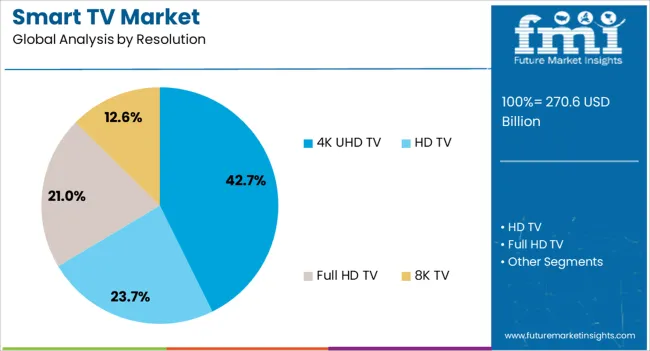
The 4K UHD TV segment, representing 42.70% of the resolution category, has maintained a dominant market position supported by improved affordability and enhanced viewing quality. Increasing consumer awareness of superior picture clarity and immersive experiences has propelled demand across both residential and commercial environments.
Technological advancements in LED and OLED panels, combined with declining production costs, have accelerated mass adoption. The availability of high-resolution streaming content and gaming platforms has further amplified consumer preference for 4K UHD models.
Manufacturers are leveraging this trend by expanding product portfolios and integrating advanced upscaling technologies Continued innovation in display brightness, color accuracy, and refresh rates is anticipated to sustain the segment’s leadership, ensuring strong revenue contribution throughout the forecast period.
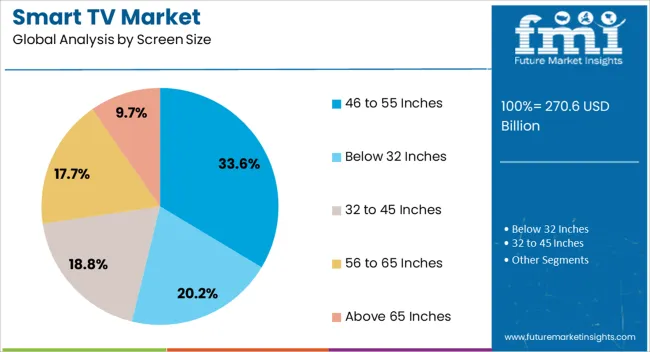
The 46 to 55 inches segment, holding 33.60% of the screen size category, has been leading due to its optimal balance between viewing comfort and affordability. Consumers are increasingly selecting this size range as living spaces modernize and home entertainment systems evolve toward larger formats.
Demand has been reinforced by its suitability for 4K content and gaming applications, offering an enhanced visual experience without significant space constraints. Retail promotions, bundle offers, and smart connectivity features have supported broader market penetration.
Manufacturers have optimized production efficiency for this segment, enabling competitive pricing while maintaining high display performance Continued adoption in both urban and suburban households, coupled with expansion in e-commerce distribution, is expected to preserve the segment’s dominant share and sustain consistent growth across major regional markets.
Industry Witnesses a Rise of Cloud Gaming Service Integration
Cloud gaming services such as Google Stadia, NVIDIA GeForce NOW, and Xbox Cloud Gaming are changing smart televisions into gaming powerhouses. This makes it possible for the users to engage in high-quality gaming experience without having to own a separate gaming console or high-end computer.
In this model, games are run straight from the servers and anyone with a device connected to the internet can play any of the available games. This is more attractive to casual gamers and people who want to engage in gaming without having to invest in peripherals. The flexibility in service delivery and cost reduction are the main factors behind the adoption of cloud gaming leading to increased smart TV sales for compatibility.
In October 2025, Netflix began testing its cloud gaming service in the United States after previously launching limited trials in the United Kingdom and Canada.
Demand for Eco-friendly Models is Higher than Ever
Currently, sustainability and energy efficiency have become significant growth factors influencing the smart TV market. Smart television manufacturers are leaving no stone unturned as they aim to remove superfluous energy consumption and use materials that are environmentally friendly. These TVs are designed to be energy efficient and can offer functions such as power-saving modes or auto-brightness control.
The concept of green products, which benefit the environment, is fascinating to customers who prefer to improve their environmental sustainability and become more environmentally friendly. Also, meeting energy standards in different regions allows manufacturers to sell products in various parts of the world without violating laws. As the concerns for environmental conservation rise, the emergence of more sustainable models can help the industry flourish.
In May 2025, Google announced the Android 14 for TV at its I/O developer conference. The updated OS aims to enhance performance, reduce power consumption, and introduce features like picture-in-picture support.
Higher Internet Penetration in Emerging Economies is Opportunistic for the Industry
Africa, Asia, and Latin America remain the backbone of venture capital investments. These regions are experiencing fast economic growth, resulting in a higher middle class with more disposable income. As internet access becomes more ubiquitous and cheaper, high-speed internet access extends to more households in these regions.
This creates grand chances for smart TV manufacturers as they can explore new customer segments. A dominant share can be achieved through affordable and good quality smart televisions that suit these markets' particular needs. Localizing content and interfaces for region-specific language and preference can also add value to the overall adaptation and consumption.
The demand for smart TVs rose at a 13.9% CAGR between 2020 and 2025. The industry generated revenues accounting USD 162.7 billion in 2020 and surpassed USD 270.6 billion by 2025. Since more companies are entering the smart television industry, the prices of smart televisions have declined and are now affordable for more people.
Consumer preferences for brands and models of Smart TVs with advanced connectivity options have led to innovations in the industry. New technologies and large volume manufacturing have made it possible for companies to produce smart televisions with better quality at cheaper prices. This has also made it possible for new startups to enter the industry due to the relatively low prices that many of the products now retail at.
With these aspects, the future of the industry seems bright, expanding at a 10.7% CAGR till 2035. Challenges for the smart TV industry include energy efficiency and compliance to regulatory requirements for data privacy and interoperability. It will be crucial for manufacturers to meet up with the changing regulations and certifications. These include Energy Star, EPEAT, HDMI among others to make them meet quality as well as safety and sustainability.
In addition, there are also certain rules regarding the privacy state like the General Data Protection Regulation (GDPR) and the California Consumer Privacy Act (CCPA). These regulations will shape how these TVs process users’ data and guarantee their privacy and security.
This section gives insights into the future smart TV market forecast in top countries. Information on regions like North America, Europe, Asia Pacific, and others has been granulated, focusing on the top countries. South Korea is anticipated to be at the forefront with a 13.1% CAGR until 2035. Japan follows next, expanding at a 12.4% CAGR until 2035. The United Kingdom is also on the list, expanding at an 11.9% CAGR till 2035. This data suggests that the Asia Pacific region is likely to lead the industry in the coming decade.
| Countries | Value CAGR (2025 to 2035) |
|---|---|
| South Korea | 13.1% |
| Japan | 12.4% |
| United Kingdom | 11.9% |
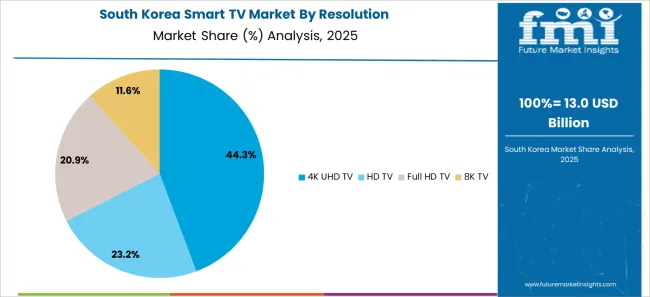
The demand for smart TVs in South Korea will rise at a 13.1% CAGR until 2035. Samsung and LG electronics companies from South Korea are leading players in smart TV industry globally and locally. They have introduced great models developed to suit the Korean marketplace. Online video streaming services such as Naver TV and Kakao TV are currently trending hence smart TV manufacturers have partnered to ensure compatibility.
The nation has a rich gaming culture, so manufacturers integrate gaming-related features into TVs. Internet usage with a higher connection makes streaming and playing various games easier. Furthermore, South Korean consumers are more sensitive to design. It has been observed that most manufacturers aim to achieve a simple yet elegant look using rich material finishes to suit the consumers.
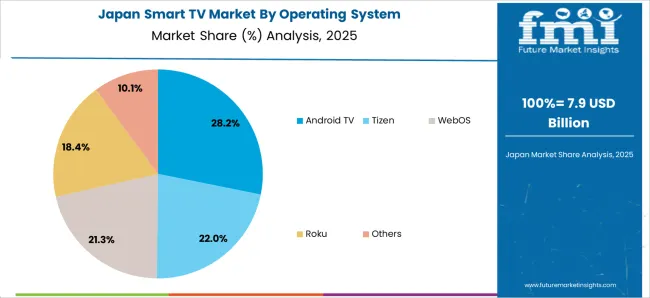
The sales of smart TVs in Japan will amplify at a 12.4% CAGR until 2035. Leading electronics firms hailing from Japan, including Sony, Panasonic, and Sharp have carved out a niche in the global smart TV industry. They are popular for designing attractive models that appeal to domestic consumers.
As Japan leads in full HD and 4K smart TV creation, meaning high-resolution TV sales skyrocket. Customers in Japan are very selective and demand quality and reliability in their electronics. As a result, manufacturers focus on the product’s ability to last and perform. Manufacturers also pay attention to cultural preferences by adding features such as anime streaming and built-in karaoke.
The market size of smart TV in the United Kingdom will expand at an 11.9% CAGR until 2035. In the United Kingdom, an increase in affordable smart TVs and streaming services has accelerated the demand for Connected TV (CTV) ads, which provide innovative and effective ways to target the audience. Energy efficiency is also important, as manufacturers invest in green technologies for their products to conform to standard requirements and consumer demands.
Freeview Play and Freesat are two digital platforms that offer free and subscription-free television with no additional costs for live and on-demand content. Also, British viewers prefer local content. Hence, smart television manufacturers and service providers integrate dedicated apps and channels with news, sports, and entertainment focused on the British audience.
This section takes a closer look at the smart TV market segmentation by operating system and screen shape. The research highlights that the Android TV is the leading operating system with a CAGR of 10.5% predicted until 2035. Under screen shape, the flat segment is predicted to expand at a 10.3% CAGR until 2035.
| Segment | Android TV (Operating System) |
|---|---|
| CAGR (2025 to 2035) | 10.5% |
Android TV offers a comprehensive entertainment experience with access to the Google Play Store's vast app library, including popular streaming services. Regular updates keep the platform competitive and secure. Seamless integration with Google services, such as Google Assistant and Google Home, enhances usability and provides advanced voice control and AI features.
Available on diverse devices from various brands, Android TV caters to different budgets, benefiting from cost-effective licensing. The platform's customizable interface allows brand differentiation, while its developer-friendly nature ensures continuous new content. Global reach and strong localization capabilities, along with Google's trusted brand image, enhance its appeal in the industry.
| Segment | Flat (Screen Shape) |
|---|---|
| CAGR (2025 to 2035) | 10.3% |
Technological advancements in Smart TV interfaces and user experiences have helped this segment thrive. Advancements in LED, OLED, and QLED technologies have enhanced flat screens' picture quality with superior brightness, contrast, and color accuracy, coupled with 4K and 8K resolution options. Their slim, lightweight designs facilitate easy handling and wall-mounting, appealing to aesthetic preferences.
Flat screens offer consistent picture quality from wide viewing angles, making them ideal for group viewing. Cost-effective production means affordable flat-screen smart TVs, with a wide range of options available in the marketplace. Flat screens also meet consumer demands for streaming and gaming, featuring high refresh rates and smart TV functionalities. These features amplify the appeal of flat screens in the market.
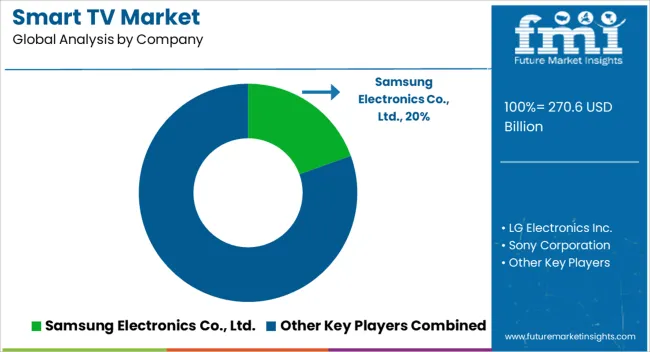
The competitive landscape of the smart TV industry consists of many intense competitors, the leaders being Samsung, LG, Sony, and other high-tech consistent companies ready to invest in improving their technology. They demonstrate varying degrees of differentiation based on the superior display technologies and enhanced features.
Companies such as TCL, Hisense, and Vizio have found market opportunities for smart TVs in the home entertainment sector through low price positioning and cost advantages. The partnerships with content providers prove to be beneficial for the improvement of their products.
Brand positioning and strategic partnerships remain popular concepts, with organizations focusing on marketing efforts and mergers for support. Impact of streaming services on the smart TV market leads to more partnerships. This competition keeps producers on their toes in developing new products, thus consumers have access to smart TVs that are more advanced and cheaper in the market.
Recent Developments
The industry is classified into Android TV, Tizen, WebOS, Roku, and Others.
The sector is segmented into 4K UHD TV, HD TV, Full HD TV, and 8K TV.
The industry is fragmented into Below 32 inches, 32 to 45 inches, 46 to 55 inches, 56 to 65 inches, and Above 65 inches.
The sector bifurcates into Flat and Curved.
The industry is classified into Online and Offline.
The sector is segregated into OLED, QLED, LED, and Others.
Analysis of the market has been conducted in the countries of North America, Latin America, Europe, East Asia, South Asia & Pacific, Middle East & Africa (MEA).
The global smart tv market is estimated to be valued at USD 270.6 billion in 2025.
The market size for the smart tv market is projected to reach USD 747.7 billion by 2035.
The smart tv market is expected to grow at a 10.7% CAGR between 2025 and 2035.
The key product types in smart tv market are android tv, tizen, webos, roku and others.
In terms of resolution, 4k uhd tv segment to command 42.7% share in the smart tv market in 2025.






Our Research Products

The "Full Research Suite" delivers actionable market intel, deep dives on markets or technologies, so clients act faster, cut risk, and unlock growth.

The Leaderboard benchmarks and ranks top vendors, classifying them as Established Leaders, Leading Challengers, or Disruptors & Challengers.

Locates where complements amplify value and substitutes erode it, forecasting net impact by horizon

We deliver granular, decision-grade intel: market sizing, 5-year forecasts, pricing, adoption, usage, revenue, and operational KPIs—plus competitor tracking, regulation, and value chains—across 60 countries broadly.

Spot the shifts before they hit your P&L. We track inflection points, adoption curves, pricing moves, and ecosystem plays to show where demand is heading, why it is changing, and what to do next across high-growth markets and disruptive tech

Real-time reads of user behavior. We track shifting priorities, perceptions of today’s and next-gen services, and provider experience, then pace how fast tech moves from trial to adoption, blending buyer, consumer, and channel inputs with social signals (#WhySwitch, #UX).

Partner with our analyst team to build a custom report designed around your business priorities. From analysing market trends to assessing competitors or crafting bespoke datasets, we tailor insights to your needs.
Supplier Intelligence
Discovery & Profiling
Capacity & Footprint
Performance & Risk
Compliance & Governance
Commercial Readiness
Who Supplies Whom
Scorecards & Shortlists
Playbooks & Docs
Category Intelligence
Definition & Scope
Demand & Use Cases
Cost Drivers
Market Structure
Supply Chain Map
Trade & Policy
Operating Norms
Deliverables
Buyer Intelligence
Account Basics
Spend & Scope
Procurement Model
Vendor Requirements
Terms & Policies
Entry Strategy
Pain Points & Triggers
Outputs
Pricing Analysis
Benchmarks
Trends
Should-Cost
Indexation
Landed Cost
Commercial Terms
Deliverables
Brand Analysis
Positioning & Value Prop
Share & Presence
Customer Evidence
Go-to-Market
Digital & Reputation
Compliance & Trust
KPIs & Gaps
Outputs
Full Research Suite comprises of:
Market outlook & trends analysis
Interviews & case studies
Strategic recommendations
Vendor profiles & capabilities analysis
5-year forecasts
8 regions and 60+ country-level data splits
Market segment data splits
12 months of continuous data updates
DELIVERED AS:
PDF EXCEL ONLINE
Smart Aerial Work Robots Market Size and Share Forecast Outlook 2025 to 2035
Smart Bladder Scanner Market Size and Share Forecast Outlook 2025 to 2035
Smart School Bus Platform Market Size and Share Forecast Outlook 2025 to 2035
Smart Home Wireless Smoke Detector Market Size and Share Forecast Outlook 2025 to 2035
Smart Bus Platform Market Size and Share Forecast Outlook 2025 to 2035
Smart Vision Processing Chips Market Size and Share Forecast Outlook 2025 to 2035
Smart Touch Screen Scale Market Size and Share Forecast Outlook 2025 to 2035
Smart Magnetic Drive Conveyor System Market Size and Share Forecast Outlook 2025 to 2035
Smart Wheelchair market Size and Share Forecast Outlook 2025 to 2035
Smart Mining Technologies Market Size and Share Forecast Outlook 2025 to 2035
Smart Parking Market Size and Share Forecast Outlook 2025 to 2035
Smart Digital Valve Positioner Market Forecast and Outlook 2025 to 2035
Smart Card IC Market Size and Share Forecast Outlook 2025 to 2035
Smart-Tag Inlay Inserters Market Analysis - Size and Share Forecast Outlook 2025 to 2035
Smart/AI Toy Market Size and Share Forecast Outlook 2025 to 2035
Smart Locks Market Size and Share Forecast Outlook 2025 to 2035
Smart Sprinkler Controller Market Size and Share Forecast Outlook 2025 to 2035
Smart Indoor Gardening System Market Size and Share Forecast Outlook 2025 to 2035
Smart Building Delivery Robot Market Size and Share Forecast Outlook 2025 to 2035
Smart Watch Market Size and Share Forecast Outlook 2025 to 2035

Thank you!
You will receive an email from our Business Development Manager. Please be sure to check your SPAM/JUNK folder too.
Chat With
MaRIA